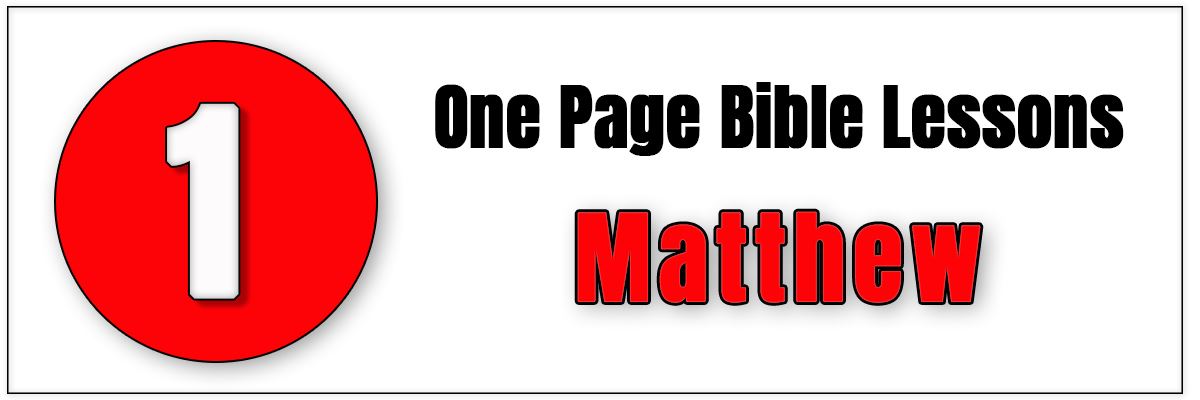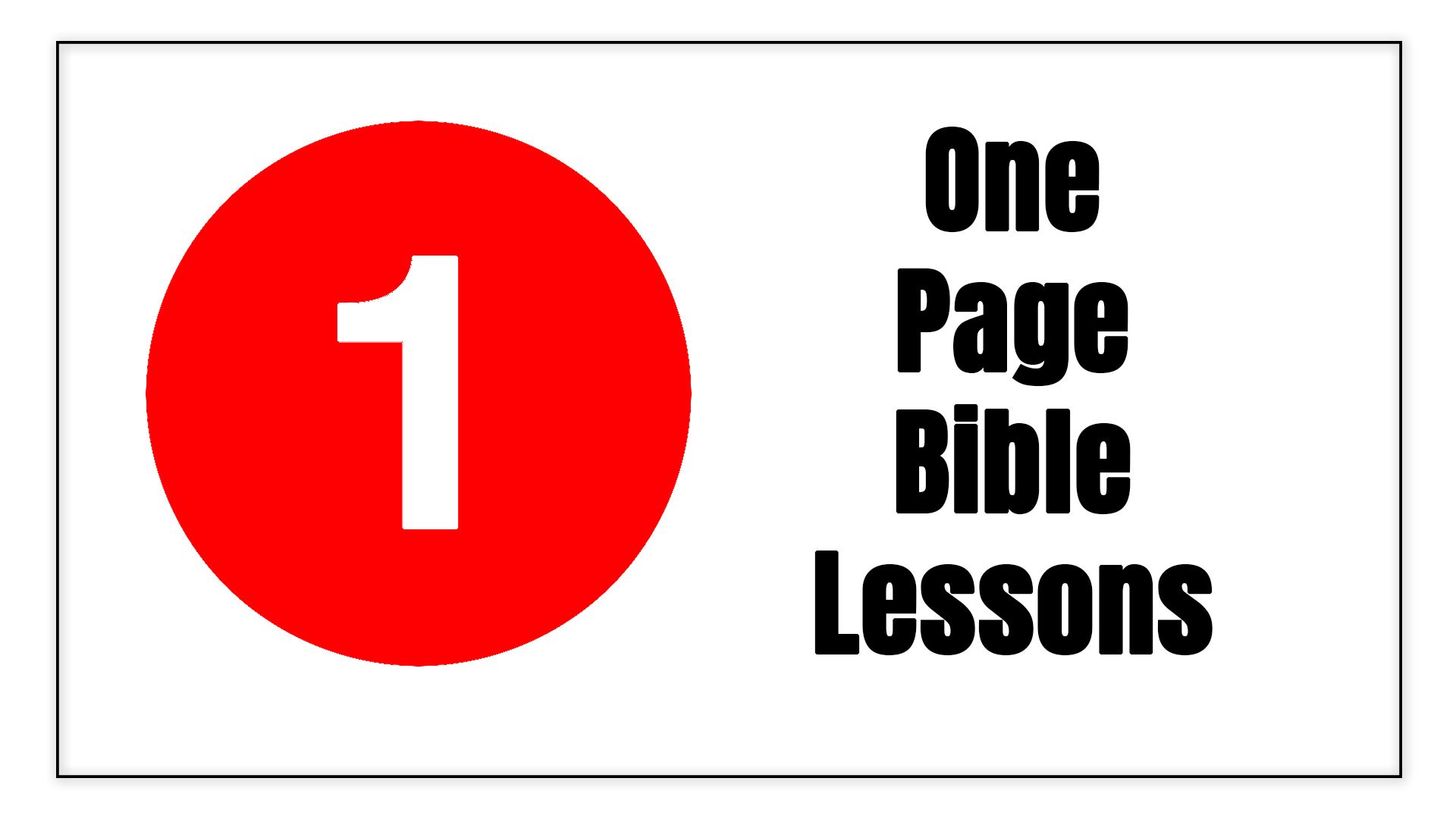
Matthew One Page Bible Study LessonsSuccession to a throne is often a time of conflict and uncertainty. David’s son Absalom tried to usurp the throne (2 Sam. 15:1–18:18). Solomon’s choice of successor lost more than half the kingdom to a traitor (1 Kin. 12:20). Menahem assassinated his predecessor in Israel (2 Kin. 15:14). Royalty is a dangerous business. This is no less true when the heir is the King of kings. If ever there was a high-stakes succession, this was it. A Man claims to be Israel’s own Messiah; of course all Israel sits up and takes notice. Of course He must prove His credentials: Who wants an impostor? The Book of Matthew presents Jesus’ credentials. It presents Jesus as the King, but King of a totally different kingdom—the kingdom of heaven. Author and Date • This Gospel does not name its author, but it does contain clues. The author knew the geography of Palestine well (2:1; 8:5; 20:29; 26:6). He was familiar with Jewish history, customs, ideas, and classes of people (1:18, 19; 2:1; 14:1; 26:3; 27:2). He was well acquainted with the Old Testament (1:2–16, 22, 23; 2:6; 4:14–16; 12:17–21; 13:35; 21:4; 27:9). And the terminology of the book suggests that the author was a Palestinian Jew (2:20; 4:5; 5:35; 10:6; 15:24; 17:24–27; 18:17; 27:53). Other details point specifically to Jesus’ disciple Matthew as the writer of this Gospel. As a tax collector, Matthew would have been literate and familiar with keeping records of money. Appropriately, this Gospel contains more references to money than any of the others. Furthermore, Matthew’s hometown was Capernaum, a village that is given special attention in this Gospel. When Capernaum is mentioned, some special description is usually attached to it (4:13; 11:23). Matthew wrote the Gospel before the destruction of Jerusalem in A.D. 70. He describes Jerusalem in the book as the “holy city” and as though it was still standing (4:5; 27:53), and he speaks of the customs of the Jews as continuing until “this day” (27:8; 28:15). Furthermore, Jesus’ prophecy (recorded in 24:2) of Jerusalem’s destruction includes no indication that it had already occurred when Matthew wrote Jesus’ words. In light of all of this, it is reasonable to conclude that the book was written sometime between A.D. 50 and 60. Emphases • The Gospel of Matthew has many Jewish overtones. For example, the term “kingdom of heaven” appears 33 times and the term “kingdom of God” four times. No other Gospel lays such stress on the kingdom; the restoration of the glories of David’s kingdom was a burning hope for many Jews at the time. Matthew clearly identifies Jesus with that hope by using the Jewish royal title “Son of David” nine times in his Gospel. Furthermore he calls Jerusalem “the holy city” (4:5; 27:53) and the “city of the great King” (5:35), both uniquely Jewish ways of referring to it. First-century Jews emphasized righteousness, and Matthew uses the words “righteous” and “righteousness” more often than the Gospels of Mark, Luke, and John combined. Matthew also discusses the law, ceremonial cleanness, the Sabbath, the temple, David, the Messiah, the fulfillment of Old Testament prophecies, and Moses—all from a Jewish point of view. He has 53 Old Testament citations and more than 70 allusions to the Hebrew Scriptures. Thirteen times, the book emphasizes that Jesus’ actions were a direct fulfillment of Old Testament prophecies. The genealogy of chapter 1 is recognizably Jewish, tracing the lineage of Jesus back through David to Abraham, the father of the Jewish people. Furthermore the Gospel mentions Jewish rulers (see 2:1, 22; 14:1) and customs such as ceremonial washing (see 15:2) without explanation, indicating that Matthew expected his predominantly Jewish audience to be familiar with such practices. Purposes • Matthew’s Gospel serves several purposes beyond presenting a mere biography of Jesus. One purpose is to prove to Jewish readers that Jesus is their Messiah and promised King. The genealogy in chapter 1 points to Christ as the One who inherited God’s promises to David of an eternal dynasty. Jesus’ use of a familiar messianic psalm in Matthew 22:41–44 would have clearly implied to any Jew that He was the heir of the Davidic throne. Even though many Jews of Jesus’ time were blind to Jesus’ identity, Gentiles (such as the wise men) identified Him as Israel’s promised King when He was a baby. Finally, the charge that hung above Jesus’ head on the Cross clearly highlights His royalty: THIS IS JESUS, THE KING OF THE JEWS (27:37). But most important, the Book of Matthew proves Jesus’ legitimate authority by highlighting His wise teaching and righteous life (7:28, 29). Another purpose of the book is to outline the characteristics of the kingdom of God, both for Israel and the church. Orthodox Jews would typically scoff at any assertion that Jesus is their Messiah, let alone their King. They would retort, “If Jesus is King, where is the promised restoration of the kingdom of Israel?” Many Jews of Jesus’ day rejected Him as Messiah, even though both Jesus and John the Baptist continually preached that the kingdom was “at hand” (3:2; 4:17; 10:7). This rejection of Jesus by the Jews is a dominant theme of Matthew (11:12–24; 12:28–45; 21:33–22:14). Because of this rejection, God postponed the fulfillment of His promises to Israel and subsequently extended His blessings to both Jew and Gentile in the church. Matthew is the only Gospel writer who speaks directly of the church (16:18; 18:17). He points to the Gentile composition of this church by including several stories of the Gentiles’ faith in Jesus: the wise men, the centurion, and the Canaanite woman. He records Jesus’ prediction that the gospel will be preached to all nations (24:14), and the commission to the disciples to “make disciples of all the nations” (28:19). Jesus’ teaching pointed to the blessings of the kingdom being extended to Gentiles. But one day, Israel will be restored to its place of blessing (see Rom. 11:25–27; 15:8, 9). A final purpose of Matthew is to instruct the church. An obvious clue to this is in the Great Commission: “teaching them to observe all things that I have commanded you” (28:20). The discipling process involves instruction in the words of Christ, and the Gospel of Matthew revolves around five of Jesus’ discourses (5:1–7:28; 10:5–11:1; 13:3–53; 18:2–19:1; 24:4–26:1). Instead of emphasizing a narrative of Jesus’ life as Mark does, Matthew uses the narrative elements in his Gospel as a setting for Jesus’ sermons. The NKJV Study Bible (Nashville, TN: Thomas Nelson, 2007), Mt. |

